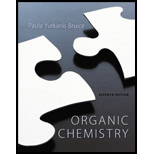
Concept explainers
(a)
Interpretation:
- The resonance contributors for the following species has to be predicted.
Concept Introduction:
Resonance Contributor: The appropriate structure with the localized electrons is called a resonance contributor, a resonance structure, or a contributing resonance structure.
Delocalized electrons: The sharing of electrons between two or more atoms known as delocalization of electrons. In order to have delocalized electrons, the system must be planar and have alternative double bonds and single bonds.
Resonance hybrid: the actual structure with delocalized electrons is called a resonance hybrid.
b)
Interpretation:
- The most stable resonance contributors for the given compounds has to be predicted.
Concept Introduction:
Resonance Contributor: The appropriate structure with the localized electrons is called a resonance contributor, a resonance structure, or a contributing resonance structure.
Delocalized electrons: The sharing of electrons between two or more atoms known as delocalization of electrons. In order to have delocalized electrons, the system must be planar and have alternative double bonds and single bonds.
Resonance hybrid: the actual structure with delocalized electrons is called a resonance hybrid.
Want to see the full answer?
Check out a sample textbook solution
Chapter 8 Solutions
Organic Chemistry; Modified MasteringChemistry with Pearson eText -- ValuePack Access Card; Study Guide and Student Solutions Manual for Organic Chemistry, Books a la Carte Edition (7th Edition)
- Ranking resonance structures Rank the resonance structures in each row of the table from major to minor. For example, in the first row, select (major) for the major resonance contributor. If two or more structures in the same row contribute equally, rank them equally by selecting the same number. X. :ö: :ö: ータ H. Rank) (Rank) H. H. H. H. H. (Rank) (Rank) (Rank) (Rank) 74°F DELL F4 F5 F6 F7 F8 F9 F10 F11 F12 PrtScr $arrow_forwardTo preview image Click here For the following bonds indicated below, choose which one would have the smallest and highest bond dissociation energy. 1. Smallest Bond Dissociation Energ: ✔ [Select] 2. Highest Bond Dissociation Energy :0 C B C H ΤῊ H A Barrow_forwardD. List resonance forms for: :0: H. CH- CH, H. a barrow_forward
- 3. Resonance forms of the acetate ion are below. :0: :0: :0: H3C H3C H3C А C a. Provide arrows that show electron movement from A to B and B to C. b. Two of these resonance forms are identical. Which two are actually the same? C. Which is the "least contributing" resonance form (A, B, or C)? Briefly explain your choice. d. Draw the resonance hybrid for the acetate ion (use "delta" &+ or- to show partial charges).arrow_forwardDetermine the relationship between Structure A and Structure B in each row of the table. Structure A Structure B Relationship O isomers H H H H Н-С— -C-NEN: N=N= C-C- H O resonance structures H. H O neither :z:arrow_forward13) Which pairs are resonance structures of one compound? X-X and A) X B) and Y-Y D) All (A, B, C)arrow_forward
- Draw resonance contributors for the following species, showing all the lone pairs: 1. CH2N2 2. N2O 3. NO-2arrow_forward4. Draw two plausible (equally or more contributing) resonance structures of the following compounds or reactive intermediates. Use arrow pushing to show the interconversion of resonance structures. a. b. C. d. H H-O-H N H N HO: B :0 :0: H H 0: 1 11arrow_forwardestion 5 of 15 The first resonance structure of the thioformate ion, HCOS, is shown. -1 : H. Determine the correct second resonance structure of thioformate ion? O..0 ..-1 0=C=S-H -1 O..0 S=C=0-H 0:0 ..-1 C%3= ī.arrow_forward
- 1. The following resonance structure are insignificant or incorrect. Explain resonance structures. alt-del 12-2 a. b. C. NH + NH 최arrow_forward3. Based on 00 a. Which compound is the least likely compound to be stable PH3 PC13 PC14 PC15 b. Which compound is most likely to be stable? B2 B₂H6 BCN BO3 c. A number of concatenated sulfur forms are known, such explanaarrow_forwardWhich of the following is a defective resonance contributor? NH₂ a) M₂C NH₂ H3C NH₂ b), H₂C NH₂ NH₂ 34₂02 2C NH₂ d) 1₂0 x² NH3 a. a O b. b O c. d O d. c A NH₂arrow_forward
 Organic Chemistry: A Guided InquiryChemistryISBN:9780618974122Author:Andrei StraumanisPublisher:Cengage Learning
Organic Chemistry: A Guided InquiryChemistryISBN:9780618974122Author:Andrei StraumanisPublisher:Cengage Learning
